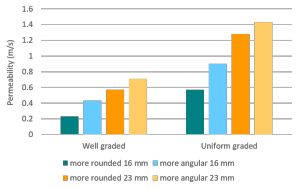Aggregates
Revision as of 18:40, 23 January 2018 by Jenny Hill (talk | contribs)
Reservoir stone and choker layer[edit]
The important characteristics of the stone within the reservoir or underdrain are the lack of fines, the void ratio and (to a lesser extent) the permeability. Porosity and permeability are directly influenced by the size, gradation and angularity of the particles [1]
Stone for erosion control[edit]
Aggregates used to line swales or otherwise dissipate energy (e.g. in forebays) should have high angularity to increase the permissible shear stress applied by the flow of water. [2] However, in some surface landscaped applications there may be a desire to use a rounded aggregate such as 'river rock' for aesthetic reasons.
Stone mulch[edit]
<ref>
- ↑ Judge, Aaron, "Measurement of the Hydraulic Conductivity of Gravels Using a Laboratory Permeameter and Silty Sands Using Field Testing with Observation Wells" (2013). Dissertations. 746. http://scholarworks.umass.edu/open_access_dissertations/746
- ↑ Roger T. Kilgore and George K. Cotton, (2005) Design of Roadside Channels with Flexible Linings Hydraulic Engineering Circular Number 15, Third Edition https://www.fhwa.dot.gov/engineering/hydraulics/pubs/05114/05114.pdf

